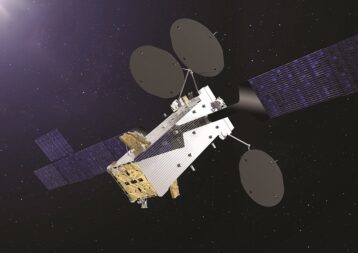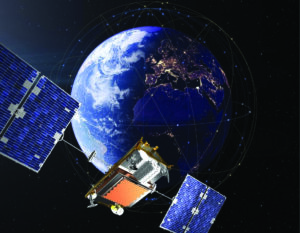ECAs came to the fore in the wake of the 2008-2009 financial crisis, helping space companies secure billions of dollars in funding as bank financing dried up and bond markets became problematic.
U.S. Ex-Im Bank, Export Development Canada and France’s Bpifrance (formerly Coface) became prominent industry influencers in the West, supporting satellite projects that fuel businesses in their home countries.
It was the attractiveness of a Coface-backed financing package that ultimately pushed Iridium Communications to choose Europe’s Thales Alenia Space over U.S.-based Lockheed Martin to build its $3 billion constellation, the satellite operator’s CEO Matt Desch told SpaceNews in an interview.
Desch said the $1.8 billion of relatively low interest, long-term ECA-backed debt it secured in 2010 was “absolutely critical” for the company at the time.
“It fit perfectly the profile of a big satellite megaconstellation build,” he said.
However, ECA debt is also notoriously restrictive, limiting shareholder dividends and the types of projects a company can invest in.
As Iridium’s risk profile improved, so did the credit markets, and in 2019 the company refinanced all of the ECA debt on better terms in the private market.
The prevalence of ECAs elsewhere in the industry also diminished amid the wider availability of funding sources. Ex-Im being embroiled in a political tussle that shut its doors to large deals from 2015 to 2019 did not help matters.
THE CASE FOR ECA FINANCING
That could be about to change as the pandemic underlines the space industry’s worth and activity ramps up across the sector.
The United Kingdom plans to leverage its UKEF export credit agency to help grow the country’s share of the global space industry following Brexit.
“There has been a strong increase in the demand for our support across a range of U.K. exporting sectors this year as we have significantly widened access to our support,” a UKEF spokesperson said.
“We are seeing a lot of demand in the wider aerospace sector and have already committed £8 billion to U.K. airlines affected by the pandemic.”
U.K. space exports reached £5.5 billion in 2019, the country’s government said earlier this year. More than a third of the sector’s income comes from exports.
How much UKEF gets involved in the space market will depend on demand and the level of support the industry gets from the private sector, the spokesperson added.

Despite the proliferation of other commercial sources of financing, such as venture capital firms and — more recently — special-purpose acquisition companies (SPACs), Ex-Im expects space firms will continue to look to ECAs to fill funding gaps left open by commercial banks.
An Ex-Im spokesperson pointed to the magnitude of funding that will be needed for large constellation projects in the future, as well as the need for more non-dilutive sources of capital at later stages of these project’s life cycles.
“EXIM has seen some pandemic-related delays in the development of space transactions that are currently under consideration,” the spokesperson said.
“However, demand for EXIM support has been robust. Over the last couple of years, and into the pandemic, EXIM has experienced a significant uptick in requests for financing of various other commercial applications such as earth observation and remote sensing, space tourism, on-orbit spacecraft servicing, and low- or medium-earth-orbit satellite constellations.”
There is also a geopolitical element at play, with the spokesperson adding that “where a competitor to a U.S. company has ECA- or state-sponsored financing behind it, EXIM is able to provide competitive financing to level the playing field for the U.S. exporter.”
Indonesia is the latest country to have tapped ECA support for a space project. Its government recently secured $545 million in funding that Bpifrance is partly backing for SATRIA, the broadband satellite that Thales Alenia Space is building. The satellite is part of a public-private partnership with established domestic satellite operator Pasifik Satelit Nusantara (PSN).
Other deals are brewing under the radar, according to a source who advises companies on debt, who said ECAs are still a good option for businesses that do not have the right credit fundamentals to be able to rely on straight commercial lending, bonds, or the frenzy of activity taking place in the SPAC-fueled public markets.
“I’m working with at least two newer businesses that are thinking about ECA financing as one of their funding options,” the person added.
However, ECA financing is still debt, which is a lot more conservative than equity when it comes to risk. The shadow of ECA-backed Newsat’s failure in Australia six years ago also likely still hangs over the market.
The best source of funding largely depends on the risk profile of the satellite project, according to Euroconsult analyst Nathan de Ruiter.
“The changing market environment from broadcast towards broadband applications and related shorter-term contracts makes it more challenging for satellite operators to secure significant pre-launch backlog,” he said.
“ECAs typically highly value pre-launch commitments to limit the market risk exposure.”
For the Indonesia deal, the country’s “government is the off-taker resulting in little to none market risk.”
51-year-old Telesat is also a good candidate for ECA because of the existing cash flow it generates in other parts of the company, where there are proven business models.
MORE RISKS IN SPACE
The space industry as a whole, however, is evolving away from the tried and true models of the past as it carves out new markets in an increasingly digital world.
Telesat and the Indonesian project pose little risk to paying back their loans compared to many of the ventures that are now dominating industry activity, according to Desch.
“Right now … our industry is generally in a big startup kind of mode, with lots of new ideas, with lots of new companies,” he said.
These ventures are helping to feed a growing appetite for risk in the equity markets, which are flocking to the sector as low-interest rates make other types of investing less appealing.
There is a lot of money looking for the kinds of returns that these space ventures are promising as they seek to transform markets with new technologies, Desch noted.
“The problem is it’s very, very high risk as well, and I don’t think … many of the companies that we see right now are candidates for export credit financing,” he said.
He added: “This is a time for equity and it’s a good thing because equity is looking for places to put their money.”
How long this environment lasts remains to be seen as venture capital also plays an ever-increasing role in an industry looking to shake up the state of play.
Armand Musey, founder of advisory firm Summit Ridge Group, said: “As technology change accelerates in the space sector, long-term take-or-pay customer contracts will likely become rarer.
“If so, it will become harder for ECAs to get comfortable with the commercial risk involved in funding many space projects. Absent ironclad contracts or government backing, the space industry will likely rely more on other sources of capital.”
For Ex-Im, it believes ECAs will continue to be an important part of the industry’s funding mix because, primarily through an arrangement with the intergovernmental Organisation for Economic Co-operation and Development (OECD), they have the ability to provide a scale of patient capital at tenures beyond what the commercial banking sector is able, or willing, to offer alone.
“The entrance of non-OECD-member ECAs offering aggressive financing for their indigenous space-industry exports has only underscored the critical role that EXIM plays in supporting the U.S. commercial space sector,” the Ex-Im spokesperson said.
This article originally appeared in the March 15, 2021 issue of SpaceNews magazine.



